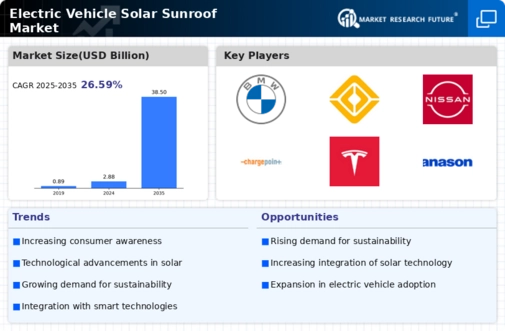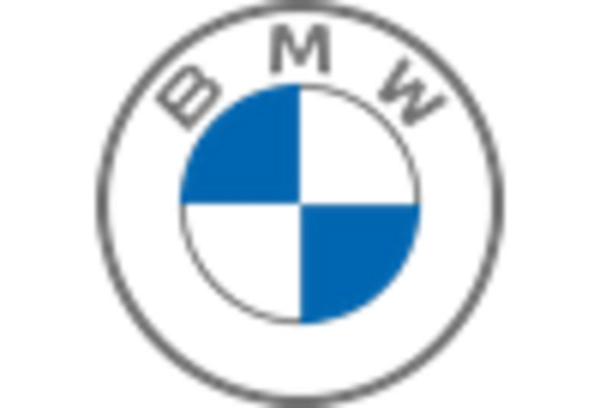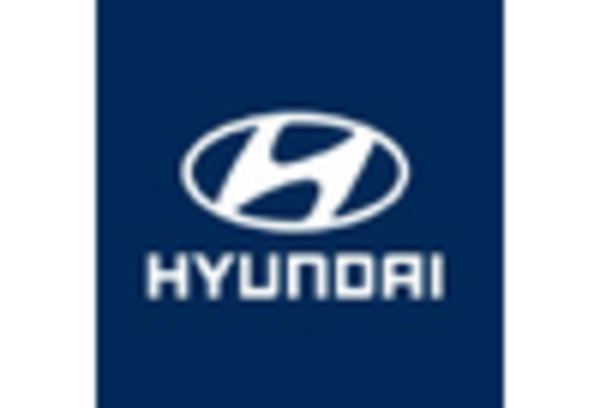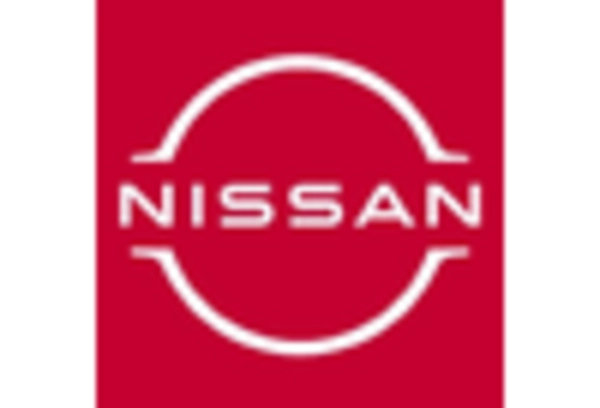Advancements in Battery Technology
The Electric Vehicle Solar Sunroof Market is poised for growth due to advancements in battery technology. Innovations in battery design and efficiency are enabling electric vehicles to achieve longer ranges and faster charging times. This is particularly relevant for vehicles equipped with solar sunroofs, as the energy harvested from sunlight can be effectively stored and utilized. Recent developments in solid-state batteries, which offer higher energy densities and improved safety, may further enhance the appeal of electric vehicles with solar integration. Market analysts suggest that as battery technology continues to evolve, the synergy between solar energy and electric vehicle performance will become increasingly pronounced. Consequently, the Electric Vehicle Solar Sunroof Market is likely to see a rise in consumer interest as these advancements make solar-equipped vehicles more practical and efficient.
Government Policies and Incentives
The Electric Vehicle Solar Sunroof Market is significantly influenced by government policies and incentives aimed at promoting electric vehicle adoption. Many governments are implementing regulations that encourage the use of renewable energy sources, including solar power. Incentives such as tax credits, rebates, and grants for electric vehicle purchases are becoming more prevalent, making solar-equipped vehicles more financially attractive to consumers. Recent data indicates that regions with robust incentive programs have seen a marked increase in electric vehicle sales, suggesting a direct correlation between policy support and market growth. As governments continue to prioritize sustainability and renewable energy, the Electric Vehicle Solar Sunroof Market is likely to benefit from these initiatives, fostering a more favorable environment for the adoption of solar technology in electric vehicles.
Rising Fuel Prices and Economic Factors
The Electric Vehicle Solar Sunroof Market is significantly influenced by rising fuel prices and broader economic factors. As fuel costs continue to escalate, consumers are increasingly seeking alternative energy solutions that can mitigate their dependence on fossil fuels. Electric vehicles equipped with solar sunroofs present a viable option, as they harness solar energy to extend driving range and reduce charging frequency. Market data indicates that the demand for electric vehicles has surged, with projections suggesting a compound annual growth rate of over 20% in the coming years. This trend is likely to drive the adoption of solar sunroofs, as consumers prioritize cost-effective and sustainable transportation solutions. Additionally, economic incentives and subsidies for electric vehicle purchases may further stimulate growth in the Electric Vehicle Solar Sunroof Market, making these vehicles more accessible to a broader audience.
Technological Innovations in Solar Efficiency
The Electric Vehicle Solar Sunroof Market is experiencing a surge in technological innovations that enhance solar panel efficiency. Recent advancements have led to the development of solar cells that can convert sunlight into energy with greater efficacy. For instance, the introduction of bifacial solar panels, which capture sunlight from both sides, has shown promise in increasing energy output. This improvement in technology not only boosts the overall performance of electric vehicles equipped with solar sunroofs but also contributes to the reduction of reliance on traditional charging methods. As a result, the market is likely to witness a growing adoption of solar sunroofs, as consumers seek vehicles that offer enhanced energy independence and sustainability. Furthermore, the integration of smart technologies that optimize energy usage may further propel the Electric Vehicle Solar Sunroof Market.
Environmental Awareness and Climate Change Initiatives
The Electric Vehicle Solar Sunroof Market is increasingly shaped by heightened environmental awareness and global climate change initiatives. As consumers become more conscious of their carbon footprints, there is a growing preference for sustainable transportation options. Electric vehicles with solar sunroofs align with this trend, as they utilize renewable energy to power the vehicle, thereby reducing greenhouse gas emissions. Recent studies indicate that electric vehicles can significantly lower emissions compared to traditional combustion engines, making them an attractive choice for eco-conscious consumers. Furthermore, government initiatives aimed at reducing carbon emissions and promoting renewable energy sources are likely to bolster the market. The Electric Vehicle Solar Sunroof Market stands to benefit from these initiatives, as they encourage the adoption of technologies that contribute to a more sustainable future.


















Leave a Comment